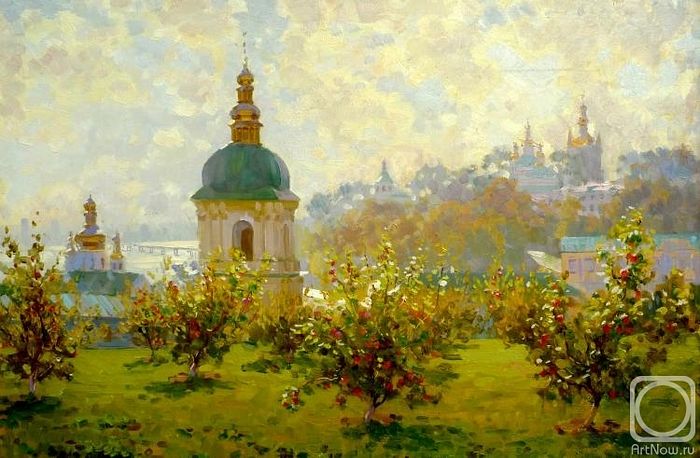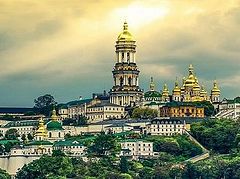In every epoch of the history of the Kiev Caves Lavra—the cradle of ancient Russian monasticism and the most famous Orthodox holy site in Ukraine—miracles are worked by the grace of God for the strengthening of the faith of the faithful. This article goes through this centuries-old chain, recalling the most vivid episodes.
The first of them, chronologically, are described in the Kiev Caves Patericon—a collection of works from the eleventh-thirteenth centuries about the Lavra’s ascetics, compiled in the fourteenth-fifteenth centuries. Many miracles of the late sixteenth-early seventeenth centuries are also recorded in the notes of Metropolitan St. Peter Mogila (†1647) and the book Teraturgima (1638) of the Lavra Hieromonk Athanasy Kalnofoisky. There are also testimonies of miracles in the Lavra in the literature of the nineteenth century, and similar testimonies are being published today.
 Kiev Caves Lavra. Artist: Boris Litovchenko
Kiev Caves Lavra. Artist: Boris Litovchenko
The main miracle
On the pages of the Patericon, the gradual arrangement of the Lavra is described as a miracle of God’s providence; also mentioned several times is the special patronage from above of the monastery’s basic needs, of its defense against its detractors; it also tells of numerous manifestations of the gifts of clairvoyance and healing on the part of the ascetics and of departed saints appearing to the living, with reports of assistance in difficult moments.
The compilers of the Patericon relied not only on eyewitness accounts and oral tradition, but also on borrowings from translated patericons, which at that time was considered normal for the genre of hagiography.
It is important, however, not to forget that the main miracle repeatedly described in the Caves Patericon is the transfiguration of the heart of the man who has embarked upon the path of asceticism, and the transfiguration of the world around the ascetic.
It is significant, for example, that among the first disciples of St. Anthony—the founder of the Lavra—were men from aristocratic families: They preferred a damp cave to the well-organized urban monasteries created by princes and populated by Byzantine monks during time of the Equal-to-the-Apostles Vladimir and the Right-Believing Yaroslav the Wise. So powerful was the impression St. Anthony made upon his contemporaries!
If you have been overcome by demons…
St. Theodosius, the disciple and most prominent companion of St. Anthony in the creation of the monastery, who devoted himself to ensuring that the Lavra not be lacking in living holiness (in the words of historian George Fedotov), and that non-acquisitiveness and brotherly love not “depart into history,” was ready to give the last of the monastery’s supplies to the needy, and by the prayers of the abbot, the Lord delivered the brethren from demonic delusions, replenished the depleted goods, and the powerful of this world stopped the oppression of those for whom the ascetic intervened.
Having suffered defeat at the hands of demons in reclusion in a cave, St. Isaac humbled his pride with foolishness,1 and when the monastery cooks jokingly asked him to bring a raven, the bird obediently sat down on the ascetic’s arm. St. Titus, daring to serve in the altar after an unresolved quarrel with a deacon friend, at the onset of a fatal illness, asked forgiveness and was healed. After the robbing of his cell, where he had secretly accumulated considerable wealth, St. Arethus fell into despondency, but, enlightened by a vision, repented and subsequently ascended to the heights of holiness.
Bedridden since childhood, St. Pimen the Much-Ailing prayed for the prolongation of his ailment so that he could remain in the monastery, where his relatives brought him in hopes of his healing—and he was accounted worthy to be tonsured by the angels themselves.
What happened after relics were mocked?
In the history of the Lavra, a miracle on Pascha in 1463 is often mentioned, when St. Dionysiy Schepa went down into the cave to burn incense over the brothers’ graves, and at his cry of “Christ is Risen!” he heard a collective voice from the tombs: “Indeed He is Risen!”
The Teraturgima, published as a continuation of the Patericon (first printed in Polish in 1635), describes numerous healings from bodily illnesses and demonic possession, a number of cases of sudden illness for mocking the relics of the saints in the caves, two stories of liberation from Turkish captivity (escape and ransom), the saving of an excavating archeologist buried in the ground, the conversion to Orthodoxy of a Catholic and a Calvinist, a pilgrimage to the Lavra of the Catholic bishop of Kiev, the intensified streaming of myrrh from a skull relic in the presence of a skeptic doctor, and hot rain over the place of the caves during the threat of fire due to the fighting between the Cossacks and Poles in 1630.
Miracles on Pascha…
There were also miracles in the Lavra in subsequent centuries. Thus, the case of the healing of the deaf and dumb Maxim Philippov on Pascha in 1823 in the Dormition Cathedral was witnessed by the prosphora-baker novice—with whom the healed man labored—Peter Krasnopevtsev, the future St. Partheny of Kiev.
On Pascha in 1853, in the Metropolitan of Kiev’s house church in the Lavra, the mute boy Vladimir Shepelev—the future St. Alexei Goloseevsky—was healed by the prayers of St. Philaret (Amphiteatrov).
In June 1876, “Russian Antiquity” published a story from the scholar and painter Theodore Solntsev about how his friend Dr. Savenko, who didn’t believe in myrrh-streaming relics, carried out an experiment with the permission of the monastery administration: He wiped one of the skulls dry and left it in a sealed room overnight. In the morning, myrrh was found in the dish with the head, which convinced the doctor of the authenticity of the miracle…
About radiation and microbes in the caves
In 1982-1990, scientific research on the relics in the Lavra’s caves showed that the level of radiation and number of microbes are reduced near these sacred treasures, and that the myrrh from the skulls does not contain by-products from the decomposition of organic substances but does contain protein in amounts characteristic of living organisms (the results of the research are published in the book, Wonders of the Lavra’s Caves, 1997, 2011).
A few years ago, the Lavra’s publishing house released a special edition: Caves Calendar 2015: Miracles of the Kiev Caves Lavra, which, recalling some of the miracles of former times, offers us numerous testimonies of miracles of recent years, in a variety of situations, including with bodily ailments (including cancer) and in dangers and hardships.



